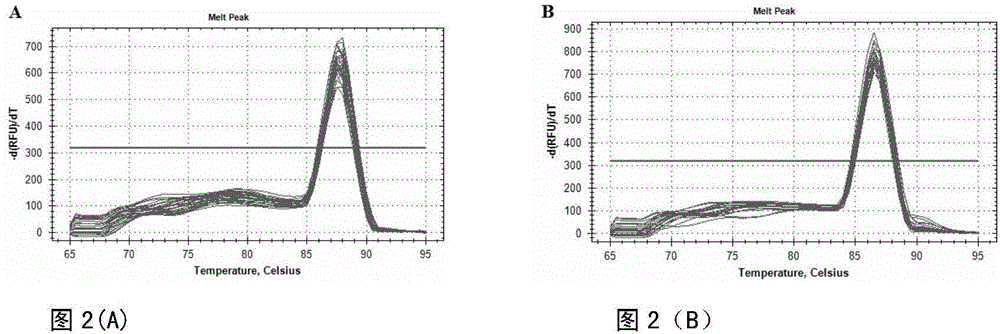Full-length cloning method for pig NLRC5 gene and fluorescent quantitative detection method for expression quantity of pig NLRC5 gene
A cloning method and expression technology, which is applied in the field of fluorescent quantitative detection of NLRC5 gene cloning and expression in porcine tissue, can solve the problems of increasing the difficulty of infectious disease treatment, pathogenic biological characteristics, antigenicity, drug resistance changes, etc. , to achieve the effect of simple operation, high detection sensitivity and good repeatability
- Summary
- Abstract
- Description
- Claims
- Application Information
AI Technical Summary
Problems solved by technology
Method used
Image
Examples
Embodiment 1
[0085] The extraction of embodiment 1RNA:
[0086] Weigh 100 mg of small intestine tissue, extract RNA by grinding with liquid nitrogen, dissolve in DEPC water, and detect RNA integrity by 1% agarose gel electrophoresis.
Embodiment 2
[0087] Embodiment 2RT-PCR:
[0088] (1) Prepare a 0.2ml centrifuge tube and add the following ingredients:
[0089] Total RNA: 6ul
[0090] 50um oligo(dT) 20 1ul
[0091] 10mM dNTP mix 1ul
[0092] DEPC-treated H 2 O 2ul
[0093] (2) Incubate at 65°C for 5 minutes, and place on ice to cool.
[0094] (3) Add the following ingredients in order:
[0095] 10×RT buffer 2ul
[0096] 25mM Mgcl 2 4ul
[0097] 0.1mM DTT 2ul
[0098] RNase OUT TM (40U / ul) 1ul
[0099] 200U / ul III RT 1ul
[0100] Total volume: 20ul
[0101] (4) Briefly centrifuge and mix well.
[0102] (5) React at 50°C for 50 minutes.
[0103] (6) React at 85°C for 5 minutes, and cool on ice.
[0104] (7) Add 1ul RNase H, centrifuge and mix, and react at 37°C for 20min.
[0105] (8) The product is stored in a -20°C low-temperature refrigerator for later use.
Embodiment 3c
[0106] Embodiment 3cDNA clone:
[0107] Firstly, referring to NLRC5 genes of human, mouse and other species, primers for segmentally amplifying pig NLRC5 gene are designed. The polymerase used in PCR amplification is TaKaRa LA Add the following components to the 50uL reaction system: TaKaRa LA Taq0.5uL; 10×LA PCR Buffer II (Mg 2+ Free) 5uL; Mgcl 2 (25mM) 5uL; dNTP Mixture (2.5mM each) 8uL; template 1uL; upstream and downstream primers 1uL; sterilized distilled water 28.5uL. The PCR reaction conditions were: 94°C for 5min, 35 cycles (94°C for 30s, 58°C for 30s, 72°C for 90s), and 72°C for 10min. The PCR product was analyzed by 1% agarose gel electrophoresis, the recovered target fragment was ligated with PMD-19, transformed into DH5a, and the bacteria solution was identified by PCR and sent to Shanghai Invitrogen for sequencing, and the sequencing results were spliced.
PUM
 Login to View More
Login to View More Abstract
Description
Claims
Application Information
 Login to View More
Login to View More - R&D
- Intellectual Property
- Life Sciences
- Materials
- Tech Scout
- Unparalleled Data Quality
- Higher Quality Content
- 60% Fewer Hallucinations
Browse by: Latest US Patents, China's latest patents, Technical Efficacy Thesaurus, Application Domain, Technology Topic, Popular Technical Reports.
© 2025 PatSnap. All rights reserved.Legal|Privacy policy|Modern Slavery Act Transparency Statement|Sitemap|About US| Contact US: help@patsnap.com



